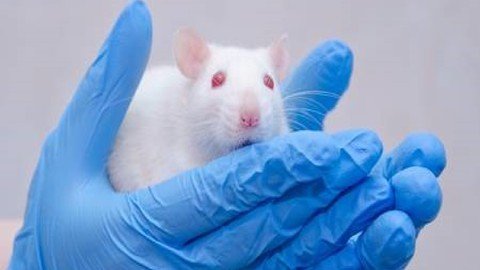Biomaterials Biocompatibility
- 23.11.2022
- 73

Last updated 8/2020
MP4 | Video: h264, 1280x720 | Audio: AAC, 44.1 KHz
Language: English | Size: 357.16 MB | Duration: 1h 14m
Biocompatibility
What you'll learn
Definition of biocompatibility and biomaterials
Study of biocompatibility from the point of view of toxicity, allergenicity, effect on genes and blood, carcinogenicity and biodegradability
Introduction of biocompatibility standards
The interaction of cells with biomaterials
Physicochemical properties of biomaterials and their biocompatibility
Compatibility blood and the factors affecting it
The process of wound healing in the presence of natural and artificial biomaterials
Requirements
System requirements: PC, laptop or mobile device (with Udemy app) and broadband connectivity.
Course requirements: There are no pre-requisite or other course requirements.
Description
Biocompatibility means the adaptation of biomaterial to biological conditions and the absence of harmful toxic effects. Scaffold biocompatibility means the ability to regenerate tissue with the body without producing harmful systemic and local responses in the host. Interaction between body and biomaterials will have a significant effect on biomaterial Function. There is a great deal of interaction between the body and the biomaterial. There are three basic characteristics of this definition: first, that biomaterial must work, second, that the best response from the body's tissues to biomaterial is necessary, and third, that biocompatibility must always be defined for a specific application. Biomaterial biocompatibility is its ability to create optimal performance in the host with an acceptable surface of connective tissue binding without creating adverse local systemic responses. The biocompatibility of scaffolding is defined as the ability of the structure to support appropriate cellular activities to optimize tissue regeneration without creating adverse systemic and local responses in the host.This course provides an overview of:- Definition of biocompatibility and biomaterials- Study of biocompatibility from the point of view of toxicology, allergenicity, effect on genes and blood, carcinogenicity and biodegradability- Introduction of biocompatibility standards- The interaction of cells with biomaterials- Physicochemical properties of biomaterials and their biocompatibility- Compatibility blood and the factors affecting it- The process of wound healing in the presence of natural and artificial biomaterialsThis course can be useful for students of tissue engineering, polymer and medical engineering and interested in this field.
Overview
Section 1: Definition of biocompatibility and biomaterials
Lecture 1 Biocompatibility definition
Lecture 2 Biocompatibility control factors
Lecture 3 Chemical biocompatibility
Lecture 4 Mechanical biocompatibility
Lecture 5 Structural biocompatibility
Lecture 6 Electrical Biocompatibility
Section 2: Study of biocompatibility from the point of view of toxicity allergenicity, ..
Lecture 7 Medical devices contact with the body
Lecture 8 Cellular toxicity
Lecture 9 External tests used to assess cell toxicity
Lecture 10 Direct contact test
Lecture 11 Extract test
Lecture 12 Agar diffusion test
Lecture 13 Cellular adhesion
Lecture 14 Cell morphology
Lecture 15 Sensitization Assays
Lecture 16 Irritation Tests
Lecture 17 Acute systemic toxicity and chronic toxicity
Lecture 18 Genotoxicity
Lecture 19 Implantation Tests
Lecture 20 Hemocompatibility
Lecture 21 Carcinogenesis Bioassay
Section 3: Introduction of biocompatibility standards
Lecture 22 Biocompatibility standards
Section 4: The interaction of cells with biomaterials
Lecture 23 Protein-biomaterial interaction (Protein properties
Lecture 24 Biomaterial surface properties
Lecture 25 Cell-biomaterial interaction
Lecture 26 Extracellular matrix and its interaction with biomaterials
Lecture 27 Tissue-biomaterial interaction
Section 5: Physicochemical properties of biomaterials and their biocompatibility
Lecture 28 Physicochemical properties of biomaterials and their biocompatibility
Lecture 29 The relationship between biocompatibility and the immune system
Lecture 30 Immune response control factors
Section 6: Compatibility blood and the factors affecting it
Lecture 31 Different types in the interaction of platelets with the surface
Lecture 32 Factors affecting blood compatibility
Section 7: The process of wound healing in the presence of natural and artificial biomateri
Lecture 33 The wound healing process
Lecture 34 Wound repair in the presence of biomaterials
Lecture 35 Natural and artificial blood vessels
Section 8: lesson's text
Lecture 36 lesson's text
This course can be useful for students of tissue engineering, polymer and medical engineering and anyone who is interested.
Homepage
https://www.udemy.com/course/biomaterials-biocompatibility/Download From 1DL
DOWNLOAD FROM 1DL.NET
Download ( Rapidgator )
DOWNLOAD FROM RAPIDGATOR.NET
Download (Uploadgig)
DOWNLOAD FROM UPLOADGIG.COM
Please Help Me Click Connect Icon Below Here and Share News to Social Network | Thanks you !